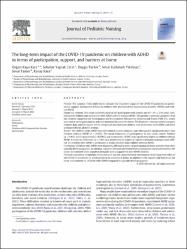| dc.contributor.author | Kara, Özgün Kaya | |
| dc.contributor.author | Çetin, Sebahat Yaprak | |
| dc.contributor.author | Türker, Duygu | |
| dc.contributor.author | Kutlutürk Yıkılmaz, Seval | |
| dc.contributor.author | Tamer, Seval | |
| dc.contributor.author | Kara, Koray | |
| dc.date.accessioned | 2023-04-17T07:35:01Z | |
| dc.date.available | 2023-04-17T07:35:01Z | |
| dc.date.issued | 2023 | en_US |
| dc.identifier.citation | Kara, Ö. K., Çetin, S. Y., Türker, D., Kutlutürk Yıkılmaz, S., Tamer, S. ve Kara, K. (2023). The long-term impact of the COVID-19 pandemic on children with ADHD in terms of participation, support, and barriers at home. Journal of Pediatric Nursing, 72, 1-8. https://dx.doi.org/10.1016/j.pedn.2023.03.009 | en_US |
| dc.identifier.issn | 0882-5963 | |
| dc.identifier.issn | 1532-8449 | |
| dc.identifier.uri | https://dx.doi.org/10.1016/j.pedn.2023.03.009 | |
| dc.identifier.uri | https://hdl.handle.net/20.500.12511/10869 | |
| dc.description.abstract | Purpose: The purpose of this study was to compare the long-term impact of the COVID-19 pandemic on participation, support, and barriers at home in children with attention deficit hyperactivity disorder (ADHD) and without ADHD. Design and methods: This study included a total of 227 participants with a mean age of 11.93 ± 2.96 years, comprising 116 children and adolescents with ADHD and 111 without ADHD. The parents or primary caregivers of all the children completed the Participation and Environment Measure for Children and Youth (PEM-CY), which was used to assess participation and environmental factors in the home. The Student's t-test was used to compare numeric data and Chi-square test to categorical data between children and adolescents with ADHD and those without ADHD in all three settings. Results: The children with ADHD were determined to play computer and video games significantly more than children without ADHD (p < 0.001). The mean frequency of participation in arts, crafts, music, hobbies (p < 0.001), school preparation (<0.0001), and homework (<0.003) was significantly higher in children without ADHD. A moderate effect size (ϕ = 0.42) was determined in respect of cognitive demands making it more difficult for children with ADHD to participate in home activities than children without ADHD. Conclusions: Children with ADHD were negatively affected in terms of participating in home activities than their typically developing peers. In addition, cognitive demands prevented their participation and involvement in the home environment while cognitive demands were a support for non-ADHD children. Practical implications: A highlight of this research was the comprehensive investigation of the long-term effect of the COVID-19 pandemic on participation in all activities at home, in addition to the support and barriers in the home environment for children with ADHD compared to typically developing peers. | en_US |
| dc.language.iso | eng | en_US |
| dc.publisher | W.B. Saunders | en_US |
| dc.rights | info:eu-repo/semantics/openAccess | en_US |
| dc.subject | Attention-Deficit/Hyperactivity Disorder | en_US |
| dc.subject | Environment | en_US |
| dc.subject | Home | en_US |
| dc.subject | Participation | en_US |
| dc.title | The long-term impact of the COVID-19 pandemic on children with ADHD in terms of participation, support, and barriers at home | en_US |
| dc.type | article | en_US |
| dc.relation.ispartof | Journal of Pediatric Nursing | en_US |
| dc.department | İstanbul Medipol Üniversitesi, Sağlık Bilimleri Fakültesi, Fizyoterapi ve Rehabilitasyon Bölümü | en_US |
| dc.authorid | 0000-0001-9120-7071 | en_US |
| dc.identifier.volume | 72 | en_US |
| dc.identifier.startpage | 1 | en_US |
| dc.identifier.endpage | 8 | en_US |
| dc.relation.publicationcategory | Makale - Uluslararası Hakemli Dergi - Kurum Öğretim Elemanı | en_US |
| dc.identifier.doi | 10.1016/j.pedn.2023.03.009 | en_US |
| dc.institutionauthor | Kutlutürk Yıkılmaz, Seval | |
| dc.identifier.wosquality | Q2 | en_US |
| dc.identifier.wos | 001058520700001 | en_US |
| dc.identifier.scopus | 2-s2.0-85151393058 | en_US |
| dc.identifier.pmid | 37023560 | en_US |
| dc.identifier.scopusquality | Q1 | en_US |


















